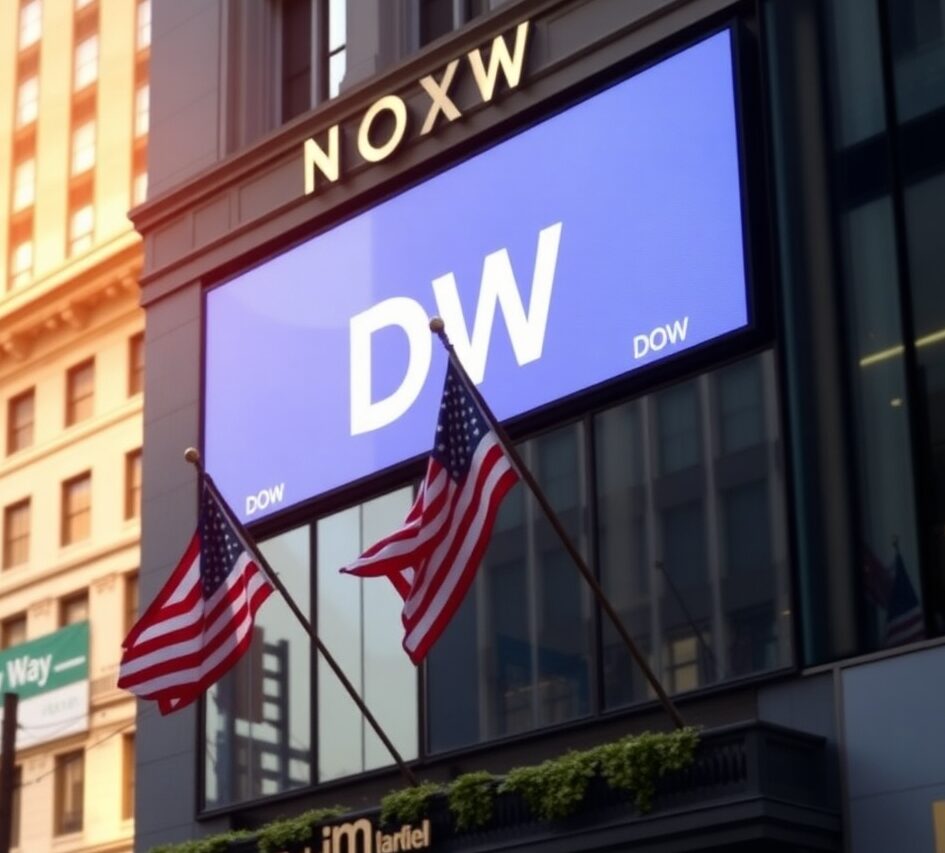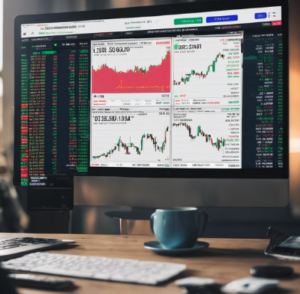
Market Volatility and Holiday Optimism
The financial markets have experienced significant swings recently, and the Dow Jones Industrial Average is no exception. Just last week, the Dow dropped more than 300 points, causing concern among investors. However, despite this drop, many experts believe the market remains poised for a positive end to 2024, as the holiday season often brings a surge of optimism and activity. This article will delve into the reasons behind the recent market movements, what investors can expect in the coming days, and how historical trends like the Santa Claus rally could provide a cushion for a strong finish to the year.
Understanding why the Dow dropped, what sectors were impacted, and how global factors came into play will help investors navigate through this volatility. Additionally, we will explore why the holiday season, despite market dips, often sees a resurgence in stock prices, fueled by investor optimism and market behaviors such as portfolio rebalancing and tax strategies.
The Dow’s Recent Decline: What Happened?
On December 18, 2024, the Dow Jones experienced a sharp drop, losing over 300 points in a single trading session. This dip was part of a broader trend of market volatility observed throughout the month of December. The loss, though significant, was not entirely unexpected, given the numerous challenges facing the market at this time of year.
Sector-Specific Losses:
One of the main contributors to this decline was a downturn in the technology sector, which has been a primary driver of market performance throughout 2024. Major tech giants like Nvidia, Apple, Tesla, and Microsoft all saw declines in their stock prices, which caused ripple effects throughout the market. The tech sector’s struggles were due to a combination of factors, including concerns about slowing growth and increased competition. The semiconductor shortage continued to disrupt the production and supply chain, especially as global demand for tech products remained high.
Global Economic Influence:
Another important factor was the global economic environment. Geopolitical tensions in regions like Eastern Europe, the Middle East, and Asia have added uncertainty to the market. Additionally, the ongoing disruptions in global supply chains have caused inflationary pressures, leading to concerns about economic slowdowns in key markets around the world. For example, the ongoing conflict in Ukraine has resulted in energy price fluctuations, and trade tensions with China have created market instability. These events can have ripple effects on market sentiment, particularly for investors with global exposure.
U.S. Economic Concerns:
At the same time, domestic factors played a role in the decline. The U.S. Federal Reserve’s policies on interest rates remain a hot topic. Despite the Fed’s efforts to tame inflation, the higher borrowing costs associated with increased interest rates have led to decreased consumer spending and slower economic growth. Consumer sentiment, which reflects the confidence of individuals in their economic prospects, dropped as a result of these conditions. The consumer sentiment index also dropped in December, reflecting concerns about inflation and the impact of higher interest rates on household budgets. With many households feeling the pinch of rising costs, consumer spending has shown signs of slowing down, which adds to the overall market pressure.
Profit-Taking and Seasonal Adjustments:
Despite these negative factors, it’s important to recognize that the Dow’s 300-point drop does not necessarily signal a long-term downturn. Market corrections are common, especially after a year of strong growth like 2024. Often, these corrections are followed by rebounds, particularly when the broader economy remains fundamentally strong. Profit-taking is another factor that often occurs toward the end of the year. Investors, particularly institutional ones, may sell stocks to lock in gains before the new year begins.
Lastly, lower trading volumes during the holiday season may have contributed to exaggerated market movements. With fewer traders in the market during this period, the volatility caused by relatively small trades can be amplified, making the markets more susceptible to larger swings.
Why the Dow’s Drop is Not All Bad News
While the recent drop in the Dow may seem alarming at first glance, it is essential to understand the broader context. The market’s year-to-date performance in 2024 has been strong, and this recent drop does not necessarily signal a long-term downturn. In fact, many investors see it as a temporary pullback before the traditional year-end rally.
Strong Overall Performance of Major Indices:
One of the key reasons for optimism is the strong performance of the S&P 500 and Nasdaq. Despite the drop in the Dow, the S&P 500 remains up over 20% year-to-date, and the Nasdaq has gained more than 25%. The resilience of these indices demonstrates that the broader market is still in positive territory, even if some sectors are experiencing temporary setbacks.
Corporate Earnings Remain Strong:
Corporate earnings in 2024 have been largely strong, with companies in sectors like healthcare, consumer goods, and energy outperforming expectations. This suggests that, despite short-term setbacks, the underlying strength of the economy remains intact. Additionally, many investors view the drop in the Dow as an opportunity to buy the dip in sectors that may rebound quickly.
Holiday Optimism and Portfolio Rebalancing:
Another factor contributing to optimism is the holiday season itself. As the year winds down, investors tend to rebalance their portfolios in anticipation of the new year. This rebalancing can lead to increased buying activity in certain sectors, particularly those expected to perform well during the holiday season. Additionally, tax strategies, such as tax-loss harvesting, can contribute to increased market activity. These factors often contribute to a positive shift in market sentiment, setting the stage for a rally.
The Santa Claus Rally:
The traditional Santa Claus rally is another reason for optimism in December. Historically, the last week of the year and the first two trading days of January have seen an increase in stock prices. The rally is often attributed to increased investor optimism, holiday bonuses being reinvested, and institutional investors adjusting their portfolios. As we approach the end of 2024, many investors are watching for this seasonal pattern to unfold, potentially providing a boost to the Dow and other indices.
Economic Stability and Consumer Spending:
The outlook for 2025 remains positive. While inflation and interest rates are ongoing concerns, the U.S. economy is still expected to grow at a moderate pace. The job market remains relatively strong, with unemployment at historically low levels, and consumer confidence has shown signs of improving. The holiday season often drives higher consumer spending, particularly on goods and services, which can help support corporate earnings in consumer-focused sectors.
Factors Behind the Dow’s Recent Drop
Several key factors contributed to the recent drop in the Dow, and understanding them is crucial for investors trying to navigate market volatility. One of the main drivers of the decline was profit-taking by investors who had seen significant gains in their portfolios throughout 2024.
Profit-Taking Activity:
Profit-taking typically occurs at the end of the year, when investors sell off some of their holdings to lock in gains before tax season. This can lead to short-term market declines, especially when large institutional investors or hedge funds decide to offload stocks to balance their portfolios or reduce taxable income. When investors sell large volumes of stock, it can create downward pressure on prices, leading to the type of drop observed in the Dow.
Tax-Loss Harvesting:
Another contributing factor is tax-loss harvesting, a strategy used by investors to sell underperforming assets in order to offset gains elsewhere in their portfolio. While this can help reduce taxes, it also leads to increased selling activity, which can put downward pressure on stock prices. Many investors engage in tax-loss harvesting at the end of the year to reduce their tax liability, adding to market volatility. This could be especially noticeable in sectors that have underperformed in 2024, like tech.
Federal Reserve Interest Rates and Inflation Concerns:
The Fed’s interest rate policies also had an impact on the market. The central bank’s decision to increase interest rates in an attempt to curb inflation has raised borrowing costs, slowing down spending and investment in the economy. Higher interest rates tend to weigh on growth stocks, particularly those in technology, which rely on cheap financing to fuel expansion. This sector has been hit particularly hard in the face of higher rates.
Global Economic Factors:
Additionally, global economic concerns have played a role in market jitters. Tensions in the Middle East and Eastern Europe have added uncertainty to the global landscape, causing investors to reassess their risk appetites. Supply chain disruptions have also continued to impact production, particularly in the tech industry, leading to shortages in key components. These global issues are interconnected, and investors are closely monitoring how they could affect the overall market outlook for 2025.
The Broader Market: A Look at Other Indices
While the Dow’s drop may have grabbed headlines, other major indices have fared better. The S&P 500, which represents a broader cross-section of the U.S. economy, has continued to show solid gains. It is important to note that the S&P 500’s broader diversification helps buffer it from sharp declines in individual sectors like technology. As a result, the S&P 500’s performance is generally less volatile than the Dow.
Nasdaq Resilience Despite Tech Struggles:
The Nasdaq, which is heavily weighted toward tech stocks, has seen significant growth throughout the year despite the recent drop. Even though tech stocks have faced headwinds, the Nasdaq’s overall performance remains strong, with several high-growth companies continuing to report solid earnings and solidifying their positions in the market. The resilience of large-cap companies like Apple and Microsoft has helped cushion the overall performance of the Nasdaq, even as smaller tech companies have struggled.
Sector Performance and Opportunities:
On the other hand, small-cap stocks have faced more volatility due to their reliance on the economic environment and more sensitive exposure to changes in consumer spending and borrowing costs. Small-cap stocks are often more impacted by rising interest rates, which have increased borrowing costs for many companies in this category. This sector has been hit harder by the Fed’s policies than larger companies with more diversified revenue streams.
Meanwhile, sector performance in the broader market has also varied. While tech has struggled, energy stocks have performed strongly due to rising oil prices and global energy demand. Companies in the healthcare sector have seen steady growth as well, driven by the continued need for medical services and products. These are sectors that may provide better opportunities for investment during periods of volatility.
Navigating the Path Ahead
As we approach the end of 2024, investors remain cautious but optimistic about the prospects for the market. The Dow’s recent decline should not be viewed as a harbinger of a long-term downturn, but rather as part of the usual market fluctuations that occur around this time of year. While challenges like interest rate hikes, geopolitical tensions, and inflation continue to impact the market, the general economic outlook remains positive.
In addition to the seasonal effects of portfolio rebalancing and tax-loss harvesting, investors should also watch for the Santa Claus rally, which often provides a boost to market sentiment during the final week of the year. With strong corporate earnings and consumer confidence, there is ample reason for cautious optimism as 2025 begins.
Ultimately, understanding the broader context behind the Dow’s movements and recognizing the opportunities in various sectors can help investors navigate market volatility and capitalize on the positive trends that may unfold as the year concludes.
Feel free to check out our other website at : https://synergypublish.com

